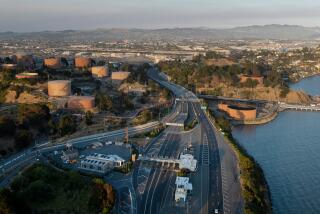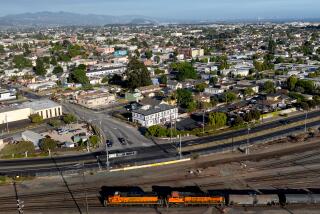Chevronâs Net Income Jumps 18%
Oil giant Chevron Corp. reported record second-quarter profit Friday on soaring oil and gasoline prices, but the companyâs shares sank because the results fell short of analystsâ expectations.
Chevronâs earnings top off a week of strong profit reports from five of the worldâs six largest publicly traded oil companies -- all reaping the rewards of the persistently high pump prices that are crimping family budgets across the country.
That fact was top-of-mind for the Foundation for Taxpayer and Consumer Rights. The Santa Monica-based consumer advocacy group noted that Chevronâs results âcapped an orgy of oil-company record profitsâ that should âfuel the ire of U.S. motorists.â
San Ramon, Calif.-based Chevron earned $4.35 billion, or $1.97 a share, in the quarter, up 18% from $3.68 billion, or $1.76, a year earlier. It was the biggest quarterly profit ever for the company, eclipsing the previous record of $4.14 billion set in the fourth quarter.
The record came despite $300 million in extra costs for uninsured damage caused by last yearâs hurricanes to oil rigs and other Gulf of Mexico facilities.
Without that expense, the companyâs earnings would have been $2.10 a share, still well below the average estimate of $2.21, according to an analyst survey by Thomson Financial.
Investors punished Chevron for the shortfall, sending the companyâs shares down as low as $64.93 a share before they rebounded to close down $1.68 at $66.05. The stock closed at an all-time high of $67.73 on Thursday.
Fadel Gheit, an analyst at Oppenheimer & Co., said he was not disappointed by Chevronâs performance.
âThis is not a shabby quarter,â said Gheit, who owns Chevron shares and rates them a âbuy.â âThey just got an A, while everybody else got an A-plus.â
So far, Chevron is the only big oil company that hasnât met Wall Streetâs second-quarter profit forecasts.
The largest among them, Exxon Mobil Corp., on Thursday reported net income of $10.4 billion for the second quarter, up 36% compared with the same period in 2005. Exxon, BP, Royal Dutch Shell, ConocoPhillips and Chevron collected more than $34.4 billion combined in profit in the three months ended June 30, equal to $379 million per day and $15.8 million an hour.
The largest share of the profits at the companies stemmed from their production of crude oil and natural gas, commodities that have fetched ever-higher prices in recent months.
The cost of crude oil, which closed at a record $77.03 a barrel July 14, continued to ease Friday, closing down $1.30 at $73.24 in New York futures trading. During the second quarter, Chevron said it received an average of $62.30 a barrel for its oil, an increase of 38% from the quarter a year earlier.
Income from the companyâs exploration and production operations rose 18% to $3.3 billion, while worldwide production of oil and natural gas rose 10% to the equivalent of 2.7 billion barrels. The production increase over last yearâs second quarter came courtesy of Chevronâs purchase of Unocal Corp. in 2005.
Some have criticized Chevron and its brethren for spending billions of dollars buying back shares and increasing dividends instead of pouring more money into expanding production and refining.
By the end of this year, Chevron will have spent $5 billion buying back shares. It spent $4.3 billion on capital and exploration projects in the second quarter, up from $2.5 billion a year earlier.
A bright spot for Chevron was the sharp increase in profit at its refining business, which includes two large gasoline-making plants in California. Income from domestic refining and marketing soared to $554 million for the quarter, up 39% from the year-earlier period and more than double the income from the first quarter of this year.
Chevron said the most striking refining profit was on the West Coast, where the company saw refining margins of $29.06 a barrel, or 69 cents a gallon, up from $20.81 a barrel, or 49 cents a gallon, a year earlier. Those increases came as Californians paid record-high gasoline prices that hit a peak in May of $3.379 for a gallon of self-serve regular.
Politicians and consumer groups have blamed oil companies for the jumps at the pump, pointing out that higher oil costs account for only a portion of the increase in gasoline prices -- a point underscored by the healthy refining margins. Oil companies have said the high prices reflected supply and demand.
The high pump prices have yet to put a dent in demand. Although polls show that consumers say they are cutting back on their driving, government statistics indicate that demand is growing compared with last year.
More to Read
Inside the business of entertainment
The Wide Shot brings you news, analysis and insights on everything from streaming wars to production â and what it all means for the future.
You may occasionally receive promotional content from the Los Angeles Times.










